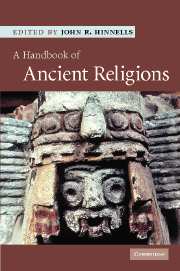Book contents
- Frontmatter
- Contents
- List of illustrations
- List of maps
- List of tables
- List of contributors
- Introduction
- 1 Palaeolithic art and religion
- 2 Ancient Egypt
- 3 Religion in ancient Ugarit
- 4 Mesopotamia
- 5 Ancient Israel to the fall of the Second Temple
- 6 Greek religion
- 7 Religions in the Roman Empire
- 8 Ancient Europe
- 9 The Indus Civilization
- 10 The religion of ancient China
- 11 Aztec and Inca civilizations
- Index
- References
3 - Religion in ancient Ugarit
- Frontmatter
- Contents
- List of illustrations
- List of maps
- List of tables
- List of contributors
- Introduction
- 1 Palaeolithic art and religion
- 2 Ancient Egypt
- 3 Religion in ancient Ugarit
- 4 Mesopotamia
- 5 Ancient Israel to the fall of the Second Temple
- 6 Greek religion
- 7 Religions in the Roman Empire
- 8 Ancient Europe
- 9 The Indus Civilization
- 10 The religion of ancient China
- 11 Aztec and Inca civilizations
- Index
- References
Summary
Introduction
There is a sense in which no religion dies, unless it be through the extermination of its believers and practitioners and the destruction of its sacred traditions. So long as there is any historical continuity, elements, however transformed in the transmission, will survive into the belief systems of the physical and cultural heirs of the community under examination. This is certainly the case with the religion of Ugarit, whose links with contiguous and subsequent cultures can be so well documented.
The city of Ugarit, rediscovered and excavated continuously from 1929 to the present day at the north Syrian coastal site of Tell Ras Shamra, 11 km north of Latakia (Map 3.1), has yielded more substantial written records than any other in the Levant throughout the ancient (BCE) period, and indeed more than all other sites in Syria, the Lebanon and Israel put together. While this archive is fairly restricted in scope, dating from the Late Bronze Age, from the late fourteenth to the first decade of the twelfth century BCE, its religious contents in particular betray wide influences, and have significant links with later religious tradition, in Greece, the Levant and in particular Israel. The importance of this material is out of all proportion to its limited quantity, and if one archaeological site should be identified as the most significant for the early history of the entire region (including Israel), Ras Shamra has perhaps the best claim.
- Type
- Chapter
- Information
- A Handbook of Ancient Religions , pp. 105 - 160Publisher: Cambridge University PressPrint publication year: 2007
References
- 2
- Cited by



